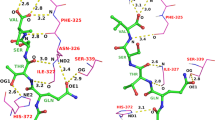Abstract
The theoretical prediction of the association of a flexible ligand with a protein receptor requires efficient sampling of the conformational space of the ligand. Several docking methodologies are currently available. We propose a new docking technique that performs well at low computational cost. The method uses mutually orthogonal Latin squares to efficiently sample the docking space. A variant of the mean field technique is used to analyze this sample to arrive at the optimum. The method has been previously applied to explore the conformational space of peptides and identify structures with low values for the potential energy. Here we extend this method to simultaneously identify both the low energy conformation as well as a ‘high-scoring’ docking mode. Application of the method to 56 protein–peptide complexes, in which the length of the peptide ligand ranges from three to seven residues, and comparisons with Autodock 3.05, showed that the method works well.








Similar content being viewed by others
References
Taylor RD, Jewsbury PJ, Essex JW (2002) J Comput Aided Mol Des 16:151
Brooijmans N, Kuntz ID (2003) Annu Rev Biophys Biomol Struct 32:335
Koehl P, Delarue M (1994) J Mol Biol 239:249
Vengadesan K, Gautham N (2003) Biophys J 84:2897
Berman HM, Westbrook J, Feng Z, Gilliland G, Bhat TN, Weissig H, Shindyalov IN, Bourne PE (2000) Nucleic Acids Res 28:235
Vengadesan K, Gautham N (2004) Biopolymers 74:476
Vengadesan K, Gautham N (2004) Biochem Biophys Res Commun 316:731
Halperin I, Ma B, Wolfson H, Nussinov R (2002) Proteins Struct Funct Genet 47:409
Bursulaya BD, Totrov M, Abagyan R, Brooks CL (2003) J Comput Aided Mol Des 17:755
Gehlhaar DK, Verkhivker GM, Rejto PA, Sherman CJ, Fogel DB, Fogel LJ, Freer ST (1995) Chem Biol 2:317
Némethy G, Gibson KD, Palmer KA, Yoon CN, Paterlini G, Zagari A, Rumsey S, Scheraga HA (1992) J Phys Chem 96:6472
Wang R, Lu Y, Wang S (2003) J Med Chem 46:2287
Lengauer T, Rarey M (1996) Curr Opin Struct Biol 6:402
Hetényi C, van der Spoel D (2002) Protein Sci 11:1729
Poornima CS, Dean PM (1995) J Comput Aided Mol Des 9:500
Chung SY, Subbiah S (1996) In: Hunter L, Klein TE, Pac Symp Biocomput. World Scientific, Hawaii, USA, pp 126–141
Mc Donald IK, Thornton JM (1994) J Mol Biol 238:777
Knegtel RMA, Antoon J, Rullmann C, Boelens R, Kaptein R (1994) J Mol Biol 235:318
Hubbard SJ, Thornton JM (1993) ‘NACCESS’: computer program. Department of Biochemistry and Molecular Biology, University College, London
Morris GM, Goodsell DS, Halliday RS, Huey R, Hart WE, Belew RK, Olson AJ (1998) J Comput Chem 19:1639
Tame JR, Dodson EJ, Murshudov G, Higgins CF, Wilkinson AJ (1995) Structure 3:1395
Tame JR, Murshudov G, Dodson EJ, Neil TK, Dodson GG, Higgins CF, Wilkinson AJ (1994) Science 264:1578
Tame JR, Sleigh SH, Wilkinson AJ, Ladbury JE (1996) Nat Struct Biol 3:998
Taylor RD, Jewsbury PJ, Essex JW (2002) J Comput Chem 24:1637
Abagyan RA, Totrov M (1997) J Mol Biol 268:678
Harel M, Su C-T, Frolow F, Silman I, Sussman JL (1991) Biochemistry 30:5217
Rosenfeld RJ, Goodsell DS, Musah RA, Morris GM, Goodin DB, Olson AJ (2003) J Comput Aided Mol Des 17:525
Jones G, Willett P, Glen RC, Leach AR, Taylor R (1997) J Mol Biol 267:727
Oberlin D, Scheraga HA (1998) J Comput Chem 19:71
Baysal C, Atilgan AR (2001) Proteins 45:62
Acknowledgments
We thank the Department of Biotechnology, Government of India for financial support under the grant no. BT/PR5476/BID/07/136/2004. We also thank the University Grants Commission, and the Department of Science and Technology, Government of India for support under the CAS program and the FIST program, respectively.
Author information
Authors and Affiliations
Corresponding author
Electronic supplementary material
Fig. 1
A Latin square of order 3. The Latin alphabets A, B, and C are used as symbols for Latin square arrangement. This pattern can be extended to any order, i.e. any number of symbols A, B, C, D (JPG 41 kb)
Fig. 2
Two mutually orthogonal Latin squares (MOLS) of order 3. The Latin alphabets A, B, and C are symbols of first Latin square. The Greek alphabets a, b, and g are symbols of second Latin square, which is orthogonal to the first Latin square (JPG 57 kb)
Fig. 3
Flow chart for the MOLS procedure (JPG 499 kb)
Fig. 4
An example of a set of mutually orthogonal Latin squares, showing three MOLS of order 7, i.e., M = 3, N = 7. Symbols in the first Latin square: a1, a2, a3, a4, a5, a6, a7. Each of these is repeated 7 times to give a total of 49 symbols, which have been arranged in a Latin square. Symbols in second Latin square: b1, b2, b3, b4, b5, b6, b7. The second Latin square is orthogonal to the first. Note that every pairing of a symbol from the first square with one from the second occurs exactly once. Symbols in third Latin square: c1, c2, c3, c4, c5, c6, c7. This is orthogonal to both the other squares. For clarity in this figure, we have used 3 different sets of N symbols. One could use the same set of N symbols and construct N-1 MOLS of order N. One of sub squares of the set of MOLS has been highlighted; its symbols are a7 of the first Latin square, b1 of the second and c5 of the third. In the present application, each symbol within the sub square represents a possible value for the corresponding torsion angle, and each sub square represents a possible conformation of the molecule. The MOLS method requires the potential function to be evaluated at each of these N2 points in the conformation space (JPG 548 kb)
Rights and permissions
About this article
Cite this article
Arun Prasad, P., Gautham, N. A new peptide docking strategy using a mean field technique with mutually orthogonal Latin square sampling. J Comput Aided Mol Des 22, 815–829 (2008). https://doi.org/10.1007/s10822-008-9216-5
Received:
Accepted:
Published:
Issue Date:
DOI: https://doi.org/10.1007/s10822-008-9216-5




